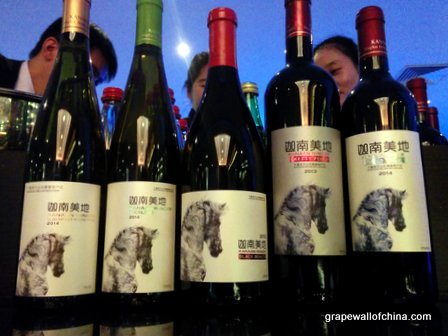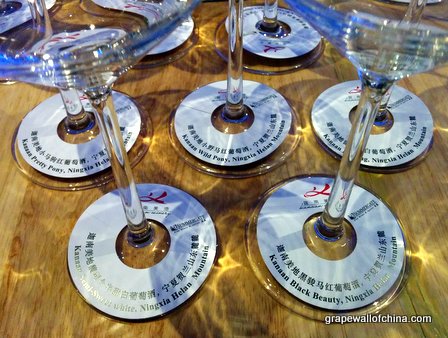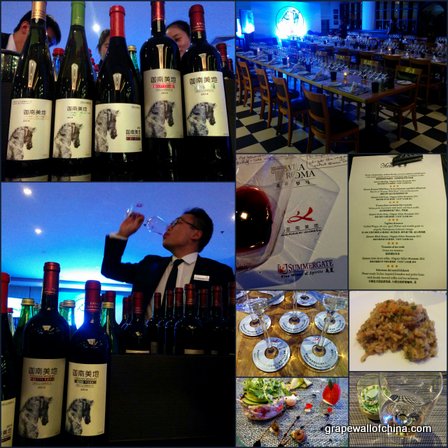
By Jim Boyce | I’ve quaffed copious amounts of Kanaan wine over the past few years, whether on visits to the winery in Ningxia or at tastings in Beijing or because I ordered 100 bottles last year to sell to readers when this producer lacked a distributor–it’s now handled by Summergate–and I opened many of them myself.
Anyway, I attended a recent Kanaan wine dinner at Via Roma in Beijing, had plenty of time to taste through the portfolio, and have listed my notes below. I’ll add that: 1) I drank a lot of Pol Roger Champagne before dinner, 2) I don’t claim to be an expert, so if you are the type that sees “mineral” listed and replies in outrage “yes, but which mineral!?”, you best stop reading now, and 3) I included two scores for each wine, one from me and one from the much tougher taster who was across from me. Let’s go!

Riesling 2014: Light fruit aromas, mostly melon, with touches of green apple and vegetable (celery?). This wine is clean and fairly easy-drinking, with a slight waxy fruit (pear) character that I find in many Chinese white wines. Plus a touch of bitterness at the end. Based on previous experience, this wine tastes much better colder. (83 / 80)
Note: I often recommend this because it’s a rare example of a decent Chinese Riesling. Also, the guy beside me was from Germany–well-known for Riesling–and he liked it.
Wild Pony Red Blend 2014: This entry-level wine was once called Gutenland but was renamed after the Summergate deal to reflect the general equine nature of Kanaan’s branding. It’s fresh and fruity, with lots of red cherry and red berries, plus a few whiffs of something funky–perhaps that latter smell is from the Cabernet Gernischt included alongside Cabernet Sauvignon and Merlot in this blend?
Like the Riesling, it is easy to drink, with some spiciness showing up quickly and with balanced tannins. Kanaan owner Wang Fang said 20 percent of this blend was aged in oak to provide balance. One person said it was smoky–“like liverwurst”. Hmm. I found the aroma increasingly sweeter–vanilla–over the course of an hour. (86 / 82)
Pretty Pony 2013: Considered a step up on Wild Pony, it has fuller and darker fruit– think blackberry and dark cherry–but a similar freshness. It also has a pleasant aroma, as though all of the smells had been lassoed by a deep red licorice scent.
In terms of taste, it was fuller and juicier, with a nice ‘mouth feel’, ample fruit (fresh dark cherry) and spice (including black pepper), and balanced tannins. You get a whiff of dry grass here and there, and, like the other reds, I found an increasingly strong vanilla smell. This one was aged in Hungarian oak (60 percent) and French oak (40 percent), split between old and new barrels. (92 / 90)
Black Beauty 2012: Yet another step up in terms of reds. The oak here lumbers against the subdued and dusty dark fruit on the nose. It’s too much for me. The juiciest of the three reds, this is a full and round Cabernet-Merlot (70 percent-30 percent) with lots of spice. It spent two years in new French oak, said Wang Fang, and hails from the tough 2012 vintage. Some ranked this as the favorite but I lean toward wines that are delicious right now and thus see Pretty Pony as the winner by several lengths, although the Black Beauty would go down well with a massive mound of barbecued meat, something of which there is no shortage in Ningxia. (88 / 85)
Semi-Sweet 2014. A Riesling, Chardonnay and Sauvignon Blanc blend with melon, unripe stone fruit and slight vegetable aromas. After an initial sweet sensation, there is a sort of waxy and slightly savory pear element. We had it with a green tea-inspired dessert that didn’t seem very sweet but was still too much for the wine. Again, I often recommend this one since it is fairly unique in China, a country where Cabernet-driven reds sit high in the saddle. (83 / 80)
In the end, the Pretty Pony was easily my favorite, a wine I would recommend visitors to China to take home and share with friends. As noted, both whites are interesting if only because these styles are relatively rare in China, and a tasting of both plus the Wild Pony red blend would be relatively inexpensive. You can find Kanaan wines at Pudao.
Note: Kanaan in Ningxia is not to be confused with Canaan just outside Beijing in Hebei, which also makes some pretty nice wines.

Check out the new online China Wine Directory. And get the free Grape Wall e-newsletter by signing up below.
Grape Wall has no sponsors of advertisers: if you find the content and projects like World Marselan Day worthwhile, please help cover the costs via PayPal, WeChat or Alipay.
Sign up for the free Grape Wall newsletter here. Follow Grape Wall on LinkedIn, Instagram, Facebook and Twitter. And contact Grape Wall via grapewallofchina (at) gmail.com.

Leave a Reply
You must be logged in to post a comment.